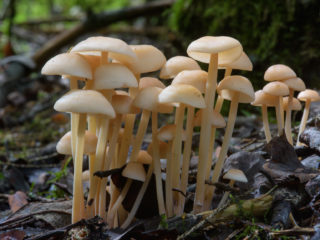Content
Collibia involucra is an inedible mushroom of the Omphalote family. The species grows in mixed forests on humus or small dry wood. In order not to harm your health, you need to have an idea of your appearance, look at photos and videos.
Description of wrapped Kollibia
Collibia wrapped or money-shod is a fragile, miniature specimen that grows in temperate regions. Since the mushroom is inedible, it is necessary to know a detailed description in order not to get an upset stomach.
Description of the cap
The cap is small, up to 60 mm in diameter.In young specimens it is bell-shaped, and as it grows it straightens, maintaining a small mound in the center. The surface is covered with thin matte skin with pronounced whitish spots. In dry weather, the mushroom is colored light coffee or cream. When it rains, the color changes to dark brown or ocher. The pulp is dense, brown-lemon.
The spore layer is covered with thin long plates, which partially adhere to the stalk. When young they are canary in color, changing to red or light brown as they mature.
Reproduction occurs by transparent elongated spores, which are found in a pale yellow spore powder.
Description of the leg
An elongated leg, widening towards the bottom, up to 70 mm long. The skin is smooth, fibrous, gray-canary in color, covered with a lemon felt coating. The lower part is whitish, covered with mycelium. The ring at the base is missing.
Is shod money edible or not?
The species is inedible, but not poisonous. The pulp does not contain poisons or toxins, but due to its hardness and bitter taste, the mushroom is not used in cooking.
Where and how does it grow
Collibia involucra is common in deciduous forests. Prefers to grow in small families, rarely single specimens, on fertile soil from July to October.
Doubles of Kollibia shod and their differences
This specimen, like all inhabitants of the forest, has similar doubles. These include:
- Spindlefoot - conditionally edible mushroom. The cap is relatively large, up to 7 cm in size. The surface is slimy, yellow or light coffee in color. It grows in small groups on dry fallen wood or deciduous substrate, bears fruit from June until the first frost. In cooking, the species is used after soaking and long-term boiling.
- Azema – edible type with a flat or slightly curved cap, light coffee color. Grows among coniferous and deciduous trees on acidic fertile soil from August to October. The harvested fruit is good when fried, stewed or canned.
Conclusion
Collibia involucra is an inedible specimen that grows among deciduous trees. To prevent it from accidentally falling into the basket and causing mild food poisoning, you need to study the detailed description, view photos and videos.













